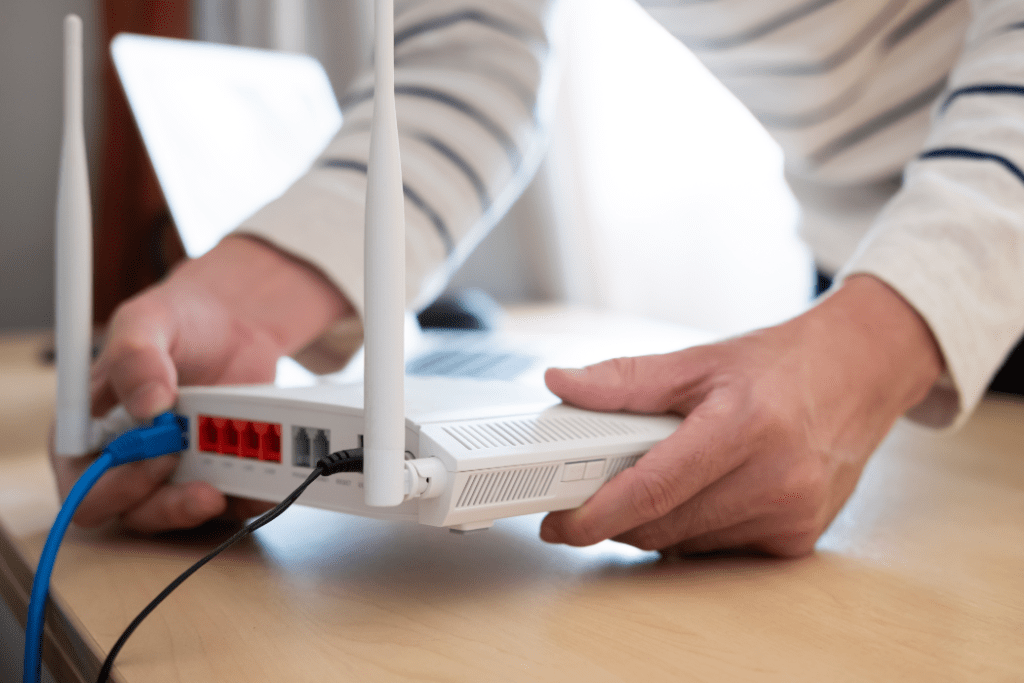Many broadband issues stem from overcapacity in certain areas. This means that multiple customers in a particular area are all using the same connection at the same time, making it more likely that your internet will be slow at times of high usage, known as peak periods.
To solve a slow broadband issue, the first step is to find out if other customers in your area are also experiencing problems with their internet service.
Slow internet connections remain a significant source of contention in the UK despite available superfast packages, due to various reasons. These issues could stem from anything from device compatibility issues or network congestion issues to seasonal fluctuations and extreme weather events.
Broadband providers offer various packages with different bandwidth speeds; however, intermittent connections may prove challenging to deal with. Stable connections allow you to work more efficiently and enjoy your movies without interruption. But what should you do if your connection goes out?

Broadband services use shared public networks and can experience congestion during peak periods, making it wiser to avoid running demanding applications during this period.
Introducing the Common Broadband Issues
Consumer advocate Which? recently conducted a survey that highlighted UK broadband problems as being of greater concern after providers raised prices earlier in the year.
And customers complaining of slow download speeds and frequent connection dropouts even as providers raised prices by over 50% year-on-year.
Ofcom receives hundreds of complaints against broadband providers each year regarding issues with faults, provisioning (such as slow internet speed or outages) or customer service and billing. These complaints are usually concerning faults that affect more than half of all households and result in disruption in over one million homes.
Note that most issues can be solved easily and won’t cost an arm and a leg to fix.
First, check if your provider is experiencing outages via Down Detector or their social media accounts. If not, this could indicate your problem may only exist at home and doesn’t need calling in customer support for a resolution.
Alternatively, try performing some simple troubleshooting steps to see if you can fix the problem yourself before calling customer support for assistance or asking for an engineer to visit your location, if all else fails
Importance of Solving Broadband Issues
As we rely increasingly on the Internet for work, home life, and leisure activities, it is becoming more critical that our broadband connection operates effectively. Unfortunately, however, broadband can sometimes experience issues, and this can be extremely frustrating.
Remember that broadband issues may not always be the fault of your provider; rather, they may stem from many different factors. Therefore, it is wise to be patient and reach out if experiencing problems.
Whenever there is an issue with the infrastructure that provides your broadband – be it an exchange, street cabinet, or your house – your provider must hand the problem over to engineers for resolution. This may take time as providers must first try everything remotely before doing so.
1. Broadband Issues – Slow Internet Speed
UK broadband speeds often fall below expectations, with an average home getting less than half of what Western European connections can deliver – for instance it takes 18 minutes in the UK to download a five-gigabyte movie while only 12 and eight minutes are necessary in Spain and Sweden respectively.
Problems are compounded by the fact that some parts of the country don’t have access to high-speed broadband internet – essential for modern life and digital lives. And even though our government has promised us superfast internet by 2025, this promise still seems far away.
There are steps you can take to improve your speed. Start by switching providers; for instance, BT offers £50 a month for line rental and landline phone, plus 80Mb up and 74Mb down on fibre.
Check if your provider implements traffic management policies during peak hours to prevent too much data usage from customers.
If possible, download during off-peak hours for best download performance and make sure any policy was detailed before signing up with them. If they do have such measures in place, however, be informed of it beforehand.
a. Broadband Issues Solution – Check Your Internet Plan
Maintaining an ideal broadband connection is of utmost importance, especially if you want to save money by getting the speeds you need and not overpaying for subpar service.
There are a lot of internet options in the UK depending on where you live and your budget. From fibre-optic cables, copper phone lines, mobile networks and satellite signals – each serving different purposes in your daily workflow.
It’s up to you to determine how important fast connections and flawless connectivity are in improving your daily tasks.
ADSL (Asymmetric Digital Subscriber Line) broadband is the most prevalent type in the UK, connecting through your regular BT landline and offering download speeds up to 24Mbps. If you’re unhappy with your current provider, there are several ways you can switch without incurring early termination charges.
There are also superfast broadband services that provide more reliable and future-proofed connections, like gigabit broadband. Gigabit broadband offers incredible 1000Mbps download speeds – perfect for streaming video, high-resolution apps and online games.
To check what speeds are available in your area, use services like the Uswitch comparison sites to compare different deals available in your postcode area. The fastest option is the gigabit broadband which should cover most households when streaming video and playing high-resolution apps or online games.
b. Broadband Issues Solution – Optimise Your Wi-Fi Signal
At a time when many of us rely on the Internet to stay in contact with friends, entertain ourselves or work, having slow or unreliable broadband can be quite demoralising. Luckily, it’s not always as bad as you might expect. And there are often solutions available that can get things back on track again.
The first step to improving your wireless signal is to relocate your router. This is because ensuring there is an uninterrupted path between devices and your router is the best way to improve wireless signals. For this reason, it is best to place it away from walls that could reduce signal strength – thicker walls have more of an effect.
Next is resetting your router and installing Wi-Fi extenders that ensure reliable connections for every room in your house.
Providers typically can resolve these issues by working directly on the technology within your home – such as routers, Wi-Fi networks and microfilters – or adding more capacity at their exchange if many customers report drops in an area.
c. Broadband Issues Solution – Clearing Browser Cache and Cookies
Clearing your browser cache and cookies regularly is vital to improving web page loading times and preventing certain types of errors from occurring.
To clear them out, you want to follow the instructions for your specific browser. Most follow a similar process, though some use Ctrl+Shift+Delete instead to quickly open up menus.
While broadband issues may be caused by your provider, there are a few simple solutions you can try at home before deciding to change providers. By following these tips you may enjoy faster and more reliable broadband that allows you to do all the things you love online.
If these remedies fail to produce results after trying them all then perhaps switching providers and finding better offers would be best.
d. Broadband Issues Solution – Use a Wired Connection
Modern broadband networks can be complex systems and, from time to time, there can be outages on them. Sometimes these outages last only minutes while others can last days or weeks; either, way they can be very frustrating experiences that mean reaching out for assistance from your provider.
Using ethernet cables can reduce stress on your wireless internet connection and enhance its reliability. If you find that it remains unstable, switching providers could offer more stable services.
If your broadband service remains unreliable, it could be caused by damage to the lines connecting your home to the network. These cables can become compromised for various reasons including general wear and tear or extreme weather. In these instances, an engineer should visit your house to repair it.
2. Broadband Issues – Intermittent Connection
Intermittent Internet connectivity issues can be highly annoying, particularly if they interrupt your work or Netflix streaming. If this problem arises for you, there are various solutions you could try to rectify the situation.
These steps include inspecting cables, rebooting both modem and router, clearing away electrical interference, and checking any changes made to router settings.
If these steps don’t solve your issue, further assistance from an ISP or IT professional might be required to resolve it. Use the status page of your ISP to identify any Internet outages in your area quickly and resolve them swiftly.
Traceroute software is another great way of pinpointing where an Internet issue may lie, which will help with troubleshooting and support services as they assist customers through troubleshooting processes.
a. Broadband Issues Solution – Restart Your Modem and Router
Turning your router and modem off and on can often solve a lot of broadband issues, particularly those related to Wi-Fi connectivity issues such as slowness or drops. A reboot may clear away any obstacles that have clogged up your network due to various causes – an ideal remedy if your Wi-Fi has become slow or intermittent.
Such issues could include new applications or downloads clogging up your network, and an overwhelming number of people streaming an event online. Or broken home equipment – something which is extremely inconvenient given how much we now rely on the internet for work, play, socialising, and gaming purposes.
If your issues persist, then reaching out to your provider is the next option. They have a duty to provide services tailored specifically to meet your needs; should this fail, you may need to switch providers – this move could save you money while offering higher speeds and saving potential.
If the usual approaches have failed to resolve your issues, switching providers might be worth exploring.
b. Broadband Issues Solution – Check for Loose Cables
If your issue does not extend across your provider network, they should be able to offer technical assistance over the phone.
They will usually guide you in inspecting both your router and any internal telephone wiring (microfilters etc). This is because cables carrying internet signals directly into your home could become damaged through general wear-and-tear, extreme weather or vandalism.
These faulty cables require engineers from your network to come out to your location and fix them, potentially leading to lengthy outages.
It is important to remember that if they detect issues at an exchange or street cabinet location they may charge an engineer visit fee.
Be sure that the F-connectors – used to connect your cable modem and master socket – are securely fastened. Otherwise, any loose connection could allow RF ingress into your network, leading to all sorts of trouble for your broadband service. For instance, in one case an old television set was giving off signals that interfered with fibre services.
While experiencing intermittent connectivity issues is perfectly normal, if these continue, it’s time to contact your provider or search around for one with better service offerings.
c. Broadband Issues Solution – Move Wi-Fi Router to a Better Location
Moving your router can often help improve signal strength and speed on Wi-Fi networks. But be mindful that it’s wired to an internet access panel (commonly referred to as a master socket).
Therefore, moving too far away could necessitate long cables which could potentially damage them – you don’t want your network being interrupted too severely by long cables!
If all else fails, your next step should be contacting your provider and asking them to send out an engineer. While this might not be quick or cheap, be patient while they work their magic on fixing your issue.
d. Broadband Issues Solution – Use a Wi-Fi Extender
Wi-Fi range extenders can be an easy, affordable way to increase broadband speeds quickly.
Unlike an ethernet cable setup which involves drilling holes in walls and running cabling throughout your home, these plug-and-play devices come equipped with easy app-based setup instructions.
These instructions include one which shows users where they should position it for maximum performance without using Wi-Fi scanning apps or trial-and-error methods. Thus saving both time and energy in setup processes, while providing a much more stable connection than competing brands.
3. Broadband Issues – No Internet Connection
Though Britain offers many superfast broadband packages, internet issues remain commonplace. They could arise for any number of reasons ranging from installing new apps to firewalls blocking even safe websites.
Here’s a step-by-step guide on how to resolve the internet connection issue so that you can get back to work as soon as possible. Start by making sure the modem and router are connected and operational before looking further into solving the issue.
a. Broadband Issues Solution – Check Power and Connection Status
Broadband access is essential in modern life and when it doesn’t work as expected it can cause significant difficulties for people and life in general. Loss of productivity, delayed tasks and disruption to keeping in touch with friends and family all play a part in it all.
There are various things you can do to assess the status of your home broadband connection and identify what has gone wrong. If these remedies fail to help, and you still cannot connect, it may be time to switch providers.
Visit your provider’s website or social media accounts to determine whether there are any problems affecting broadband connectivity in your area.
They often provide more detailed updates regarding network issues, with an estimate for when they will be resolved. They may also offer information as to whether it affects just you personally or multiple properties in a neighbourhood.
b. Broadband Issues Solution – Contact Your Internet Service Provider (ISP)
There are a good number of UK Internet Service Providers (ISPs) providing broadband services to millions of consumers, each one offering different packages and terms and conditions; some providers may be more highly regarded than others in terms of the quality of their service provision.
If your broadband service is not performing as intended, the first thing to do should be to visit your provider’s website or social media feed and see if any issues have been identified as prevalent across their entire customer base, or just with your particular address. This will give you an idea if this problem is widespread or only localised to one house.
Ofcom has issued a voluntary Code of Practice for Broadband Speed that requires major ISPs to inform new customers of the minimum access line speed they should expect at home as part of an estimate and what should happen if their speeds fall short of this goal. Among them are Virgin Media and alternative FTTH/P providers such as CityFibre, Hyperoptic and Gigaclear who do not subscribe.
c. Broadband Issues Solution – Resetting Modem and Router
Modern broadband networks are complex, and it is normal for households that rely on them heavily to experience periodic connectivity loss. But in certain instances, this disruption can stretch over several days or weeks and have an enormously detrimental impact on those who use it extensively for working and socialising online.
Rebooting the router or modem may be all it takes to solve broadband issues quickly. Restarting simply shuts it off and turns it back on without affecting any settings or software configurations.
However, be mindful that resetting will erase everything about your device, including settings and software configurations.
Restarting might seem like an unusual suggestion from an IT department or tech support agent, but it’s one of the easiest and quickest solutions available for troubleshooting purposes. Try giving your modem and router a quick reboot now to see if this helps improve your internet connection!
Broadband Issues – What to do if your broadband isn’t working: Video
4. Broadband Issues – wifi network not showing
If you are having trouble connecting to your wireless router, the first thing that you should do is try to make sure that your device is properly connected. This could be a simple matter of making sure that your device has an adequate amount of power or that the correct cable is connected.
It could also be that the device is running in airplane mode or is plugged into the wrong port on your wireless router.
Additionally, these other strategies might help:
a. Broadband Issues Solution – Enable Wi-Fi on Your Device
After experiencing intermittent internet issues, one of the quickest and easiest ways to reconnect is by activating your device’s Wi-Fi.
While exact steps vary slightly depending on the device used, generally you’ll need to open either your settings or swipe down from the top of an iPhone/ iPad’s Control Centre menu and tap the WiFi icon (which looks like three curved waves stacked one upon another) which appears.
On Android phones and tablets you may also swipe down from notification bars, open Wi-Fi settings directly, or choose it from a list displayed when WiFi is activated.
Notably, if your broadband speeds are capped and there may be faster options available in your area, it may be worthwhile contacting your supplier and asking if you can upgrade.
Often this upgrade comes free of charge and could save you the frustration of being stuck with slow connections when faster ones could exist in your region.
Keep your router up-to-date. Internet companies frequently release updates that can protect against malware slowing down your router and decreasing internet speeds.
In addition, administrators should be able to log in as administrators to modify network settings in order to maximise the performance of the connection and resolve problems such as WiFi “black spots” – very poor connection areas.
b. Broadband Issues Solution – Restart Wi-Fi Router
Most broadband issues revolve around signal dropouts, slow speeds and router issues.
When encountering difficulties with your network connection, the best course of action may be restarting and retesting the router/modem and testing again for connectivity. This should typically solve the issue.
Restarting your Wi-Fi router flushes away temporary files and resets it back to its baseline settings. Just ensure all devices are powered off before beginning. It may take several minutes until complete.
c. Broadband Issues Solution – Reconnect to the Wi-Fi Network
When your devices stop functioning as expected or display a disconnected internet symbol, first check if they have an established connection to the network. If not, disable firewall software temporarily before enabling it again to determine whether the issue lies within your network or is due to specific pieces of hardware.
Unfortunately, even fast broadband connections may experience slow speeds or Wi-Fi dead zones from time to time. The good thing is that there are ways to increase their speed and eliminate irritating interruptions from disrupting your day.
If you are having difficulties connecting your computer, phone, tablet, or printer to a wireless router, this wikiHow will show you how to reconnect it. In most cases this should simply require selecting your network and entering its password when prompted; however, more complex problems might require further investigation if your connection keeps dropping out or slowing down.
As the first step of any problem-resolution process, restarting your device is often the quickest solution. Rebooting can clear any temporary files and restore their baseline state, often providing quick relief for most issues.
Rebooting and reconnecting your router and modem may also help alleviate broadband issues, also known as a soft reset. Unplugging them for several seconds before plugging them back in can often solve many common internet-related problems – often through pressing one of the power buttons located on either front or side.

Broadband Issues: Frequently Asked Questions
How can I troubleshoot common broadband issues?
Troubleshooting common broadband issues can be a breeze! First, try restarting your router and modem. If that doesn't work, check all the cable connections to ensure they are securely plugged in. You can also run a speed test to see if your internet speed is within the expected range. If all else fails, contacting your internet service provider (ISP) for assistance is always a good idea.
What should I do if my broadband connection keeps dropping?
Oh no, the dreaded dropped connection! Fear not, there are a few things you can try. Start by rebooting your router and modem, as this often resolves the issue. If the problem persists, check for any physical obstructions or interference that may be affecting your signal. Moving your router to a central location in your home can also help. Don't hesitate to contact your ISP if you need further assistance.
How can I improve my broadband speed?
Need a little boost in your broadband speed? One quick fix is to make sure you're using the latest Wi-Fi technology, such as Wi-Fi 6, to take full advantage of faster speeds. Additionally, positioning your router away from other electronic devices and minimizing the number of walls between your device and the router can help improve signal strength. For a more permanent solution, consider upgrading your internet plan or contacting your ISP to discuss options.
My broadband connection seems slow, what can I do?
Slow broadband speed can be quite frustrating! Start by running a speed test to determine if you're getting the expected speed. If it's slower than expected, try connecting your device directly to the router using an Ethernet cable to rule out any Wi-Fi issues. Clearing your browser cache and closing any unnecessary applications or tabs can also free up some bandwidth. If the problem persists, reach out to your ISP for further assistance.
What should I do if my broadband is not working at all?
Yikes, no internet at all? Time to spring into action! Check if there are any known outages in your area by visiting your ISP's website or contacting their customer support. If there are no reported outages, try restarting your modem and router. Double-check that all the cables are securely connected and consider trying a different Ethernet cable if possible. Don't hesitate to reach out to your ISP for further guidance.
Are there any common broadband issues during bad weather?
Mother Nature can sometimes wreak havoc on your broadband connection. During bad weather, issues such as rainwater seeping into cables or strong winds causing disruptions may occur. Unfortunately, there's not much you can do in these instances other than to wait it out. If you experience frequent weather-related broadband issues, consider discussing solutions with your ISP, such as protective coverings for outdoor cables.
Is it normal for my broadband speed to fluctuate throughout the day?
Oh, the rollercoaster ride of fluctuating speeds! Don't worry, it's quite common for broadband speeds to vary throughout the day due to peak usage times. If you notice significant and frequent fluctuations, it might be worth checking if any background applications or devices are consuming a large portion of your bandwidth. If the issue persists, contacting your ISP to discuss possible solutions is a good idea.









